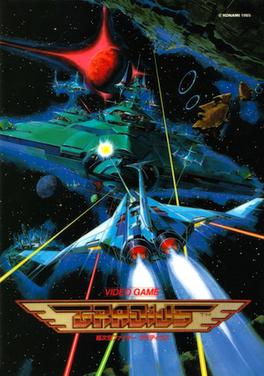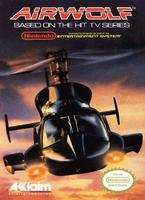
Bubble Bobble is a 1986 platform game developed and published by Taito for arcades. It was distributed in the United States by Romstar, and in Europe by Electrocoin. Players control Bub and Bob, two dragons that set out to save their girlfriends from a world known as the Cave of Monsters. In each level, Bub and Bob must defeat each enemy present by trapping them in bubbles and popping, who turn into bonus items when they hit the ground. There are 100 levels total, each becoming progressively more difficult.

Gradius is a side-scrolling shooter video game developed and published by Konami. The first game in the Gradius series, it was originally released as a coin-operated arcade game in 1985. The player maneuvers a spacecraft known as the Vic Viper that must defend itself from the various alien enemies. The game uses a power-up system called the "power meter", based upon collecting capsules to purchase additional weapons.

Contra is a run and gun video game developed and published by Konami, originally developed as a coin-operated arcade video game in 1986 and released on February 20, 1987. A home version was released for the Nintendo Entertainment System in 1988, along with ports for various home computer formats, including the MSX2. The arcade and computer versions were localized as Gryzor in Europe, and the NES version as Probotector in PAL regions and France.

Double Dragon is a beat 'em up video game series originally developed and published by Technōs Japan. It began with the release of the arcade game Double Dragon in 1987. The series features twin martial artists, Billy and Jimmy Lee, as they fight against various adversaries and rivals.

Bad Dudes Vs. DragonNinja, also known simply as either Bad Dudes or DragonNinja, is a side-scrolling cooperative beat 'em up game developed and released by Data East for arcades in 1988. It was also ported to many computer and game console home systems.

Ikari Warriors, known as Ikari in Japan, is a vertically scrolling run and gun video game released for arcades by SNK in 1986. It was published in North America by Tradewest. At the time there were many Commando clones on the market. What distinguished Ikari Warriors were rotary joysticks and a two-player cooperative mode. The rotary joystick controls were in turn based on SNK's earlier TNK III (1985). Ikari was originally intended to be an official licensed adaptation of the film Rambo: First Blood Part II (1985), but SNK were initially unable to acquire the rights to the film.

Choplifter is a military themed scrolling shooter developed by Dan Gorlin for the Apple II and published by Broderbund in 1982. It was ported to Atari 8-bit computers the same year and also to the VIC-20, Commodore 64, Atari 5200, ColecoVision, MSX, and Thomson computers.

The Nintendo VS. System is an arcade system that was developed and produced by Nintendo. It is based on most of the same hardware as the Family Computer (Famicom), later released as the Nintendo Entertainment System (NES). As Nintendo was planning to release the NES in North America, they were aware of the video game crash of 1983 and its effects on the home console market. However by March 1984 the arcade industry recovered enough for a plan to introduce NES titles there, with the VS. System later being a presentation to players who did not yet own the console. It became the first version of the Famicom hardware to debut in North America.

Kung-Fu Master, known as Spartan X in Japan, is a side-scrolling beat 'em up developed by Irem as an arcade video game in 1984, and distributed by Data East in North America. Designed by Takashi Nishiyama, the game was based on Hong Kong martial arts films. It is a loose adaptation of the Jackie Chan, Sammo Hung, and Yuen Biao film Wheels on Meals (1984), called Spartan X in Japan, with the protagonist Thomas named after Jackie Chan's character in the film. The game is also heavily inspired by the Bruce Lee film Game of Death (1972), which was the basis for the game's concept. Nishiyama, who had previously designed the side-scrolling shooter Moon Patrol (1982), combined fighting elements with a shoot 'em up gameplay rhythm. Irem and Data East exported the game to the West without the Spartan X license.

Fantasy Zone is a 1986 arcade video game by Sega, and the first game in the Fantasy Zone series. It was later ported to a wide variety of consoles, including the Master System. The player controls a sentient spaceship named Opa-Opa who fights an enemy invasion in the titular group of planets. The game contains a number of features atypical of the traditional scrolling shooter. The main character, Opa-Opa, is sometimes referred to as Sega's first mascot character.

Rush'n Attack, also known as Green Beret in Japan and Europe, is a run-and-gun and hack-and-slash video game developed and released by Konami for arcades in 1985, and later converted to the Nintendo Entertainment System and home computers. Its North American title is a play on the phrase "Russian attack" due to its Cold War setting. It was ported to home systems and became a critical and commercial success for arcades and home computers.

Bionic Commando is a video game franchise consisting of an original arcade video game released in 1987 and several later versions and sequels. The games are platform games in which, with two exceptions, the player cannot jump. A bionic arm is used to cross gaps and climb ledges. The player character, Nathan "Rad" Spencer, uses this as a grappling gun/hook to swing, climb and descend through levels. Seven games have been released, from the original 1987 Bionic Commando to 2011's Bionic Commando Rearmed 2. The series is based in an alternate timeline in which Nazism is not completely eradicated following World War II.

Hudson's Adventure Island, known as Takahashi Meijin no Bōken Jima in Japan and also known as Adventure Island, is a side-scrolling platform game produced by Hudson Soft that was released in Japan for the Famicom and MSX on September 12, 1986. Adventure Island was released in North America for the Nintendo Entertainment System in 1988 and in the PAL region in 1992.

Guerrilla War, released in Japan as Guevara (ゲバラ), is an overhead run and gun video game developed and published by SNK. Originally released in 1987 as a coin-operated arcade game, Guerrilla War was ported to the Amstrad CPC, Apple II, Commodore 64, MS-DOS, Nintendo Entertainment System, PlayStation Network, and ZX Spectrum.

Double Dragon is a 1987 beat 'em up video game developed by Technōs Japan and distributed by Taito for arcades across Asia, North America and Europe. It is the first title in the Double Dragon franchise. The game's development was led by Yoshihisa Kishimoto, and it is a spiritual and technological successor to Technos' earlier beat 'em up, Nekketsu Kōha Kunio-kun (1986), released outside of Japan by Taito as Renegade; Kishimoto originally envisioned it as a direct sequel and part of the Kunio-kun series, before making it a new game with a different cast and setting.

Wardner is a side-scrolling platform game developed by Toaplan and published in arcades worldwide by Taito in 1987.

Bionic Commando, originally released as Hitler's Resurrection: Top Secret in Japan, is a platform game released by Capcom for the Family Computer and Nintendo Entertainment System in 1988. It is based on the 1987 arcade game Bionic Commando.

Rolling Thunder is a run and gun video game developed by Namco in Japan and Europe and released in 1986 as a coin-operated arcade video game using the Namco System 86 hardware. It was distributed in North America by Atari Games. The player takes control of a secret agent who must rescue his female partner from a terrorist organization. Rolling Thunder was a commercial success in arcades, and it was released for various home computer platforms in 1987 and the Nintendo Entertainment System in 1989. The original arcade game has been included in various classic game compilations as well. It influenced later arcade action franchises such as Shinobi and Time Crisis, which borrowed mechanics such as taking cover behind crates.

Super Contra, known as Super Contra: The Alien Strikes Back in Japan, is a run and gun video game by Konami, originally released as a coin-operated arcade video game in January 1988. It is the sequel to the original Contra and part of the Contra series. The game stars Bill Rizer and Lance Bean as they are sent to thwart another alien invasion from the vicious Red Falcon.

Metal Gear is an action-adventure stealth video game developed and published by Konami for the MSX2. It was released for the system in Japan and parts of Europe in 1987. Considered to have popularized the stealth game genre, it was the first video game to be fully developed by Hideo Kojima, who would go on to direct most of the games in the Metal Gear series. A reworked port of the game was released for the Famicom a few months later, which later saw release in international markets for the NES over the following two years; this version was developed without Kojima's involvement and features drastically altered level designs, among other changes. An emulated Famicom version came with the special edition of Metal Gear Solid: The Twin Snakes on GameCube. A more faithful port of the MSX2 version was later included in Metal Gear Solid 3: Subsistence for the PlayStation 2, as well as in the HD Edition of the same game released for the PlayStation 3, Xbox 360 and PlayStation Vita, with these newer ports featuring a revised translation and additional gameplay features. The MSX version was also released for Wii Virtual Console and PC.


















